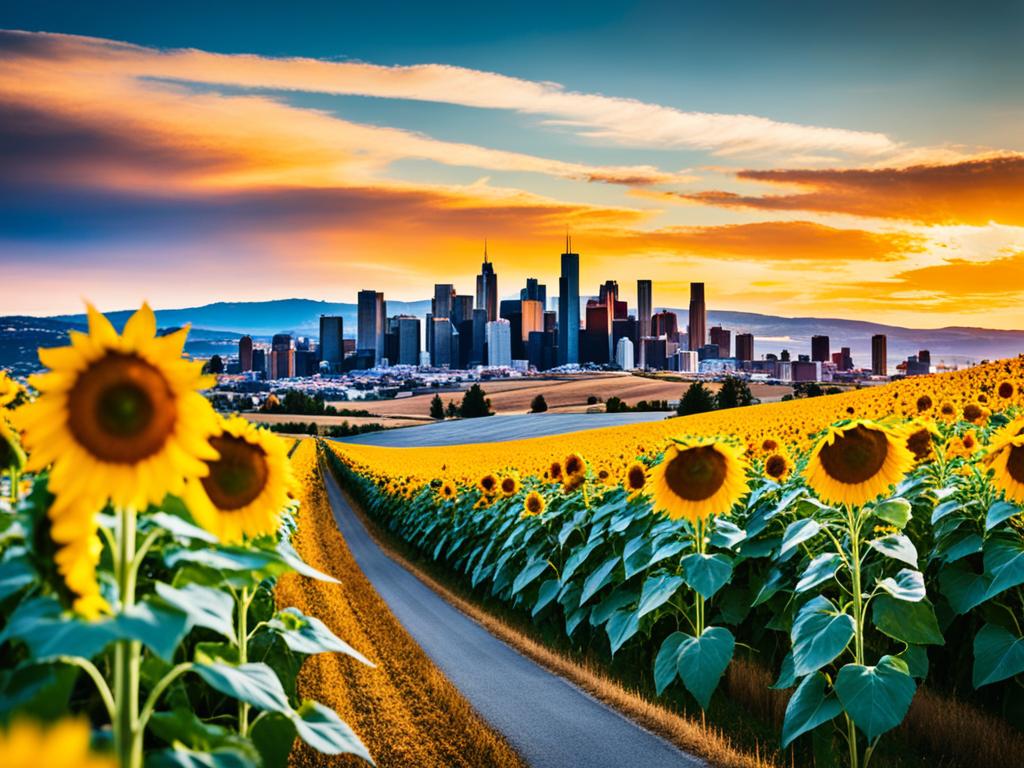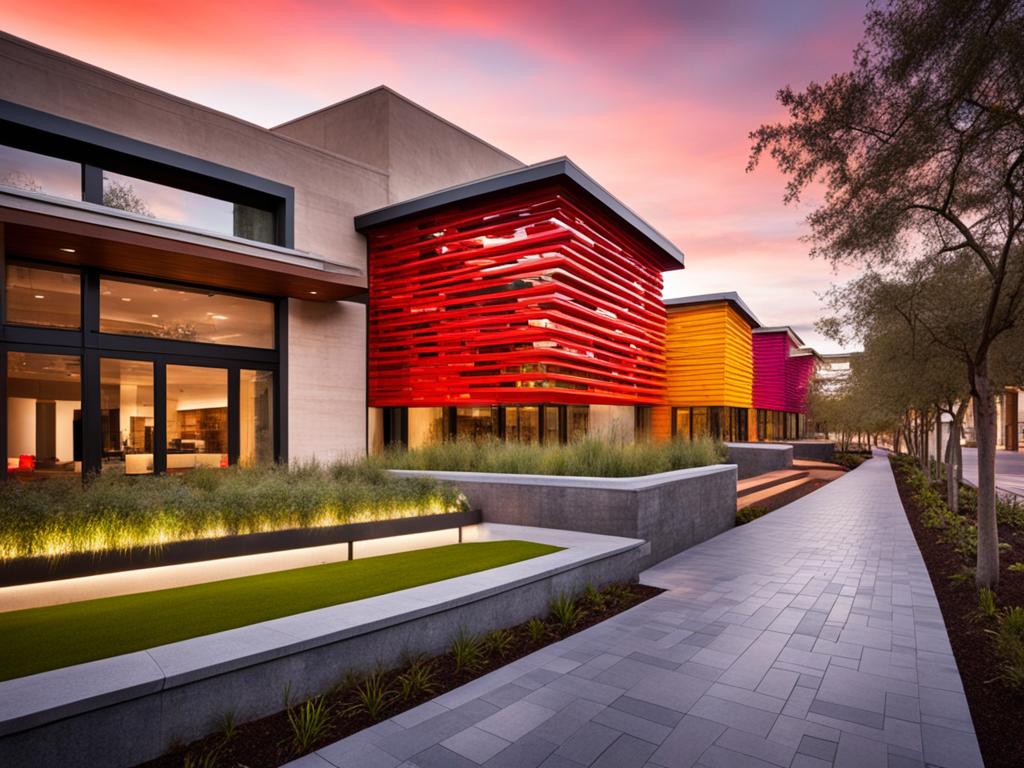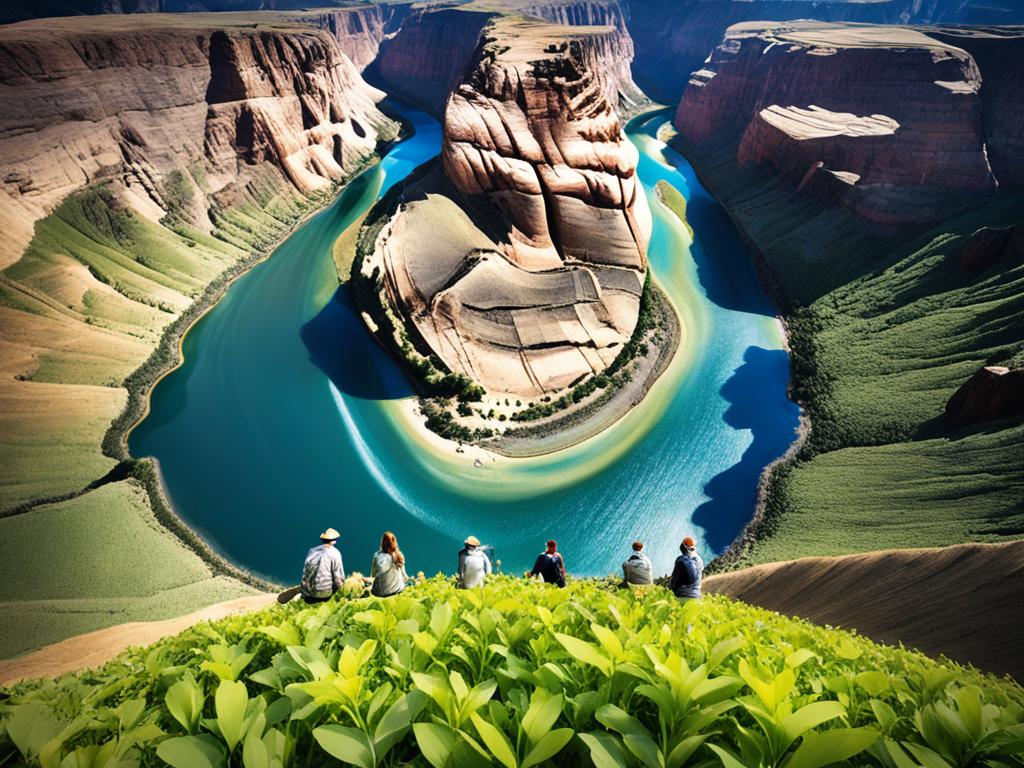Cultural landscapes are the combined results of nature and human work. They show how human society and living have changed over time. This change is because of nature’s limits and possibilities, along with social, economic, and cultural factors. These places are where humans and nature meet. They show how people use land in smart ways and how they see nature’s importance. Saving these landscapes helps us learn how to use land well today. It also helps keep nature’s beauty in the places we live. When people keep using land in old ways, it helps keep different plants and animals alive in many places.
Key Takeaways
- Cultural landscapes represent the evolution of human society and settlement over time, influenced by the physical environment and social, economic, and cultural forces.
- They embrace the interaction between humankind and its natural environment, often reflecting sustainable land-use practices and a spiritual relation to nature.
- Protecting cultural landscapes can contribute to sustainable land-use and maintain or enhance natural values in the landscape.
- The continued existence of traditional land-use practices supports biological diversity in many regions.
- Cultural landscapes are recognized as an important part of cultural heritage and are protected by international instruments like the World Heritage Convention.
What are Cultural Landscapes?
Cultural landscapes are the meld of nature and human creations over time. These areas show how our societies have evolved. They also tell stories about our connection with nature and our ways of using land wisely.
Definition and Scope
These sites are called the “combined works of nature and of man.” They show the growth of human settlements and society. Ranging from vast areas to very small spaces, they include various types like historic and ethnographic landscapes.
Significance and Authenticity
These landscapes are important for many reasons. They often have unique ways of using land in a sustainable manner and a special connection to nature. They can teach us how to use the land today and help protect natural values. Preserving these sites also helps maintain a variety of plant and animal life.
It is very important to keep these areas true to their original form. This way, we can truly understand their historical and cultural value.
Types of Cultural Landscapes
There are three main categories of cultural landscapes: designed landscapes, organically evolved landscapes, and relict landscapes. The National Park Service adds a fourth type, known as continuing landscapes. These categories show how people have shaped their environments over time.
Designed Landscapes
Designed landscapes are made by people for looks or use. Think of historic gardens, parks, and even roads. They show off planning and design from their time, along with cultural values and design ideas.
Organically Evolved Landscapes
Organically evolved landscapes grow over time from people living with nature. You can find this in places where people have shaped the land for their needs. This includes farms, villages, and factories.
Relict Landscapes
Relict landscapes once changed but stopped evolving at some point. Even though you can see the old changes, the way the land is used now is different. You might see old towns, roads that are not used, or places where factories used to be.
Continuing Landscapes
Continuing landscapes still play a part in how we live today. They are linked to old ways and keep changing. This shows how people and nature keep affecting each other. Think of farms, special places, or areas in cities that have been there for a long time.

Cultural Landscapes in the National Park System
The U.S. National Park System has over 800 cultural landscapes. These places vary a lot in how they look, their size, when they were made, and their importance. They show the different ways people have lived and changed the land over many years.
Identification and Management
The National Park Service looks after these cultural landscapes. It sees them as part of the rich cultural resource it protects. It has a detailed plan to find and care for these special places, making sure they stay for future times.
Landscape Characteristics
The National Park Service talks about thirteen main parts that make up any cultural landscape. This includes things like the land itself, how people used and moved through it, their traditions, and the way they built things. All these aspects together help us understand the stories of these places.
The National Park Service sees four main types of cultural landscapes. These are designed, natural, historic sites, and places that show how different groups of people lived. Every type needs special ways to protect and take care of it.
Cultural Traditions and Adaptations
The way people and the world around them affect each other is called human-environment interaction. Cultural ecology talks about this close connection. Everywhere, people have used what nature gives them to live. In doing so, they have also changed the land they live on. This teamwork of cultural traditions and environmental adaptations has led to the many ways of life we see around us.
Traditional Ecological Knowledge
Indigenous and local groups hold traditional ecological knowledge. It’s the wisdom and practices passed down for generations. This wisdom is about the ecosystems, natural resources, and how to care for the land properly. Knowing these things is key to managing the lands where cultural expressions thrive.
Biocultural Diversity
Biocultural diversity connects the variety of human cultures to the richness of nature. The ways people live and work with their environment are part of this. It has created stunning human-environment interactions in the cultural landscapes of diverse communities. Keeping this biocultural diversity alive is vital for the health and cultural value of these places.

Landscape Stewardship and Conservation
Keeping cultural landscapes safe helps the Earth stay healthy and beautiful. When we protect these areas, it means we’re using the land wisely. Also, it helps keep the special plants and animals safe. This happens because the way some people care for the land helps all kinds of life thrive in different parts of the world.
Participatory Mapping
Participatory mapping is a neat way to get people involved in taking care of important places. It lets locals and experts make maps together. This includes the special knowledge people have about their areas. Including their insights is key to protecting the land properly.
People are getting more chances to speak up about how the land is used. In fact, over half of them join in discussions about the land’s future. This helps make sure that everyone’s views and the land’s health all get considered. The result is that efforts to keep the land well are more successful and lasting.
Indigenous Land Management Practices
Many special places have been looked after by native groups for a long time. These people have passed on knowledge for taking care of the land from one generation to another. Their ways are all about keeping the land and the life on it in balance.
About 41% of people really connect with nature, and 30% act to protect it because of their love for certain places. This is important for managing the land right. By listening to and working with these groups, we can do much better in saving nature and respecting the people who live there.
The European Landscape Convention shows that caring for the land in a broad way is really working in some places. A big reason is that this approach links the land, the people, and nature in a deep way. This helps these systems stay strong for a long time.
Cultural Landscapes and Globalization
The world is becoming more connected, making cultural landscapes more alike. In the past, areas had their unique cultures suited to their environments. Yet, global influences are making landscapes everywhere more similar. This change affects both cultural diversity and our impact on nature.
Anthropogenic Landscapes and Environmental Impact
As our world connects more, our impact on the environment is growing. Human activities now heavily shape landscapes, impacting the earth. Projects like the Three Gorges Dam in China, displacing 1.2 million, show how big these impacts can be.
Habitat Modification
Globalization speeds up changes to natural habitats through deforestation and urban growth. These changes can throw off ecosystems, causing loss of species and harming our natural resources.
Resource Exploitation
The more our economy globalizes, the more we exploit resources, from near and far, to keep up with demand. This over-uses our natural spaces, depleting resources and changing how we traditionally used the land.
We must find a balance as globalization reshapes cultural landscapes. Protecting cultural variety and nature is key. Using resources wisely and protecting our environments is a must. This approach is vital for tackling 21st-century landscape challenges.

Sense of Place and Cultural Identity
Cultural landscapes are deeply rooted in community sense of place and cultural identity. They show the important ties between people and their environments. These landscapes reveal spiritual expressions and artistic expressions unique to each culture.
Cultural heritage preservation is vital to keep these place identities real. It lets future generations connect with the unique mix of human and environment interactions.
Spiritual and Artistic Expressions
The link between cultural landscapes and human identity is clear in spiritual expressions and artistic expressions. These include things like sacred sites, religious rituals, and local arts.
These expressions show the strong connections between people and their environments. They’re also key to passing on cultural knowledge and practices to new generations.
Cultural Heritage Preservation
Keeping cultural landscapes alive is crucial as the world changes. Efforts to protect and manage these sites are more important than ever. They protect the unique human-environment interactions that define these places.
This way, the sense of place and cultural identity of communities stays strong. Even with modernization and globalization, these efforts keep the culture alive.
World Heritage Cultural Landscapes
In 1992, the spotlight shone on world heritage cultural landscapes. That year, the World Heritage Convention made a groundbreaking move. It recognized this kind of cultural heritage legally for the first time. The Convention set guidelines for adding cultural landscapes to the esteemed World Heritage List. It called them creations that are both natural and man-made. Such landscapes show how our society and living spaces have changed over time.
Selection Criteria
Cultural landscapes must qualify under ten criteria to be a World Heritage site. These rules consider if the landscape shows important interactions between humans and nature. They also look at whether it’s linked to key events or living practices. The beauty or cultural value must be exceptional as well.
Notable Examples
The Rice Terraces in the Philippine Cordilleras, the Fertö / Neusiedlersee Landscape in Austria and Hungary, and Sweden’s Laponian Area are stand-out world heritage cultural landscapes. These sites offer different ways people have adapted to their environment over time. They highlight the great variety and depth of our cultural landscapes.
Challenges and Future Directions
The management and conservation of cultural landscapes face big challenges today. One major issue is globalization. It has made many cultural landscapes look the same. This is because local ways have been replaced by more common ones. Companies often change nature as they use resources. This can mess up the right balance between people and the land.
We also need better ways to keep track of and take care of cultural places. This needs new ideas, like participatory mapping and using traditional ecological knowledge. These can help show how people and nature are connected in unique ways.
For the future, experts say we need to focus more on landscape stewardship. They want to learn from indigenous land management to use land wisely and keep nature’s value. They also think it’s important to protect our cultural past by saving these special places through the World Heritage Convention.
Source Links
- https://whc.unesco.org/en/culturallandscape/
- https://www.nps.gov/subjects/culturallandscapes/understand-cl.htm
- https://whc.unesco.org/documents/publi_wh_papers_07_en.pdf
- https://www.nps.gov/articles/cultural-landscapes-101.htm
- https://library.fiveable.me/ap-hug/unit-3/cultural-landscapes/study-guide/04ci5UfeG5zOvfialbX5
- https://www.cambridge.org/core/books/science-and-practice-of-landscape-stewardship/human-and-social-dimensions-of-landscape-stewardship/582BE0CFD4131785BE9BCEF364DADA2C
- https://www.nps.gov/orgs/1412/upload/landscapeConservation-508.pdf
- https://opentext.wsu.edu/introtohumangeography/chapter/4-2-the-cultural-landscape/
- https://www.nationalgeographic.org/encyclopedia/landscape/
- https://www.thenatureofcities.com/2016/05/26/sense-of-place/
- https://www.ncbi.nlm.nih.gov/pmc/articles/PMC7590019/
- https://www.fao.org/fileadmin/user_upload/giahs/docs/WorldHeritage_CulturalLandscapes_MechtildRoessler.pdf
- https://researchers.mq.edu.au/en/publications/world-heritage-cultural-landscapes
- https://whc.unesco.org/en/series/7/


